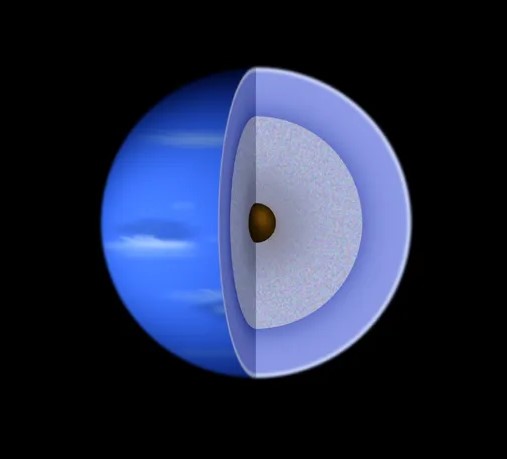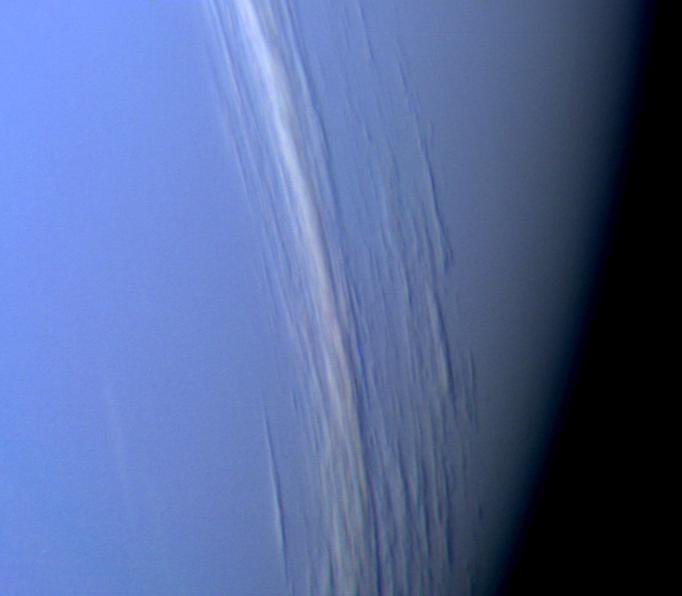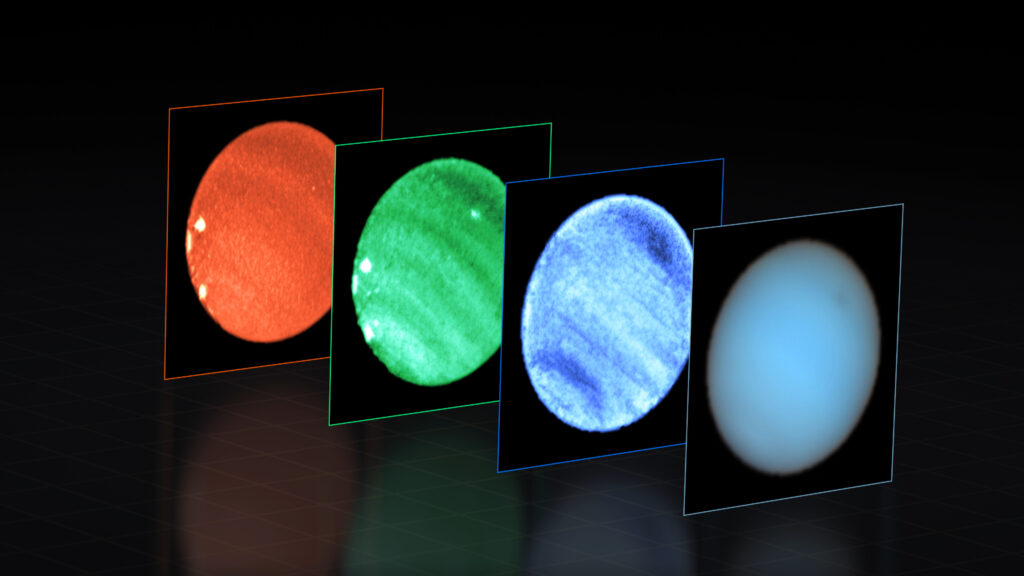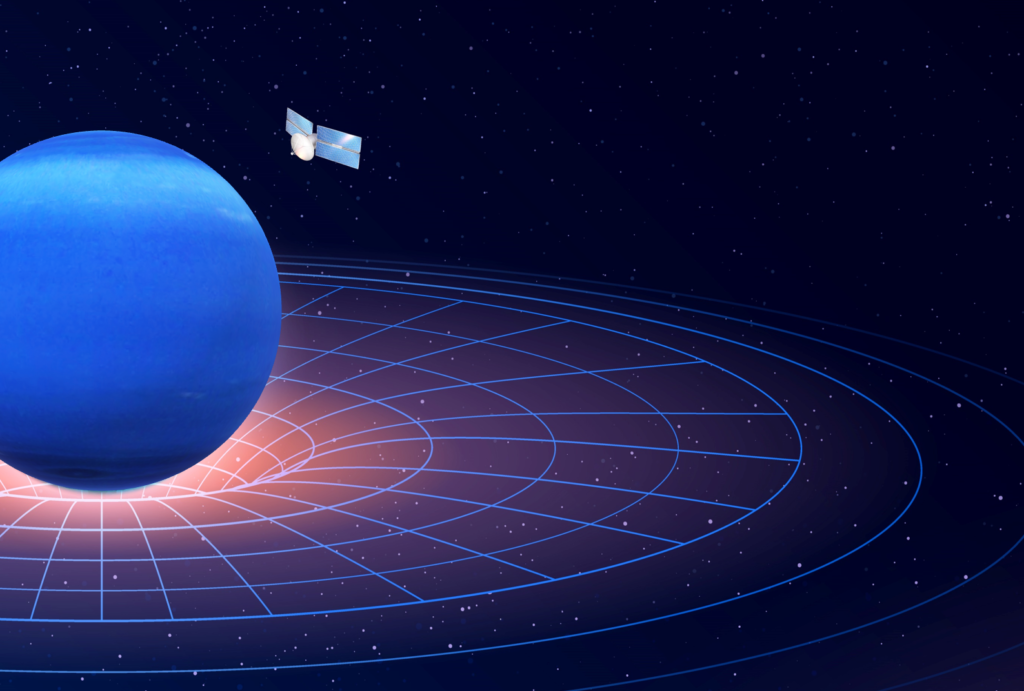The Enigmatic Blue Giant
© NASA/JPL
Neptune is the eighth and farthest planet from the Sun and was the first to be predicted before it was discovered. It is the fourth-largest planet in the Solar System by diameter, the third-most massive planet in the solar system and the densest giant planet. The planet orbits the Sun once every 164.8 years at an average distance of 30.1 astronomical units (4.5 billion kilometers; 2.8 billion miles). Neptune follows an orbit that is nearly perfectly circular, resulting in only minor variations in its distance from the Sun throughout its roughly 164-year revolution.
Despite Pluto having a greater mean distance from the Sun than Neptune, its highly eccentric orbit means that for approximately 20 years of each orbit, Pluto is closer to the Sun than Neptune.
This bluish gas giant in our solar system surpasses Earth in size, with a mass over 17 times that of our home planet, and is slightly more massive than its counterpart, Uranus. Neptune is denser and physically smaller than Uranus due to the greater gravitational compression of its atmosphere resulting from its higher mass. Given its substantial distance from Earth, it is not visible to the naked eye. Even with a small telescope, it appears as a diminutive, pale blue-green disk.
The blue giant is composed primarily of gases and liquids; it has no well-defined solid surface but, it has a rocky core like Earth. Neptune, akin to the gas giants Jupiter and Saturn, primarily comprises hydrogen and helium, with traces of hydrocarbons and potentially nitrogen. However, it contains a higher proportion of ice elements like water, ammonia, and methane. Much like Uranus, its interior is predominantly composed of a mixture of ice and rock, placing both planets in the category of “ice giants.”
In contrast to Uranus, Neptune’s atmosphere exhibits dynamic and discernible weather patterns. For instance, during the Voyager 2 mission in 1989, the planet’s southern hemisphere boasted a Great Dark Spot akin to Jupiter’s Great Red Spot. More recently, in 2018, a newer prominent dark spot, as well as a smaller one, were identified and studied. Furthermore, Neptune experiences the most robust and sustained winds of any planet in the Solar System, with recorded speeds soaring up to 2,100 km/h (580 m/s; 1,300 mph).
Neptune boasts 14 moons (natural satellites), with only two known before the Voyager 2 spacecraft’s flyby in 1989. Additionally, it features a ring system, which was confirmed during Voyager’s visit. Much of our knowledge about Neptune, including its rotational period and the characteristics of its magnetic field and magnetosphere, stems from this single spacecraft encounter. Recent advancements in Earth-based observational technology have also contributed to our understanding of the Neptunian system.
The formation of ice giants like Neptune and Uranus remains a challenge to model accurately. Current models suggest that the density of matter in the outer regions of the Solar System may have been insufficient to explain the formation of such large bodies through the conventional method of core accretion. Various hypotheses have been proposed to account for their formation, including the idea that the ice giants may not have formed through core accretion, but rather from instabilities within the original protoplanetary disc. It’s also speculated that their atmospheres might have been stripped away by radiation from a nearby massive OB star.
ABOUT THE PLANET – NEPTUNE
Neptune possesses a mass of approximately 1.0243×1026 kg, positioning it between Earth and the larger gas giants. It surpasses Earth’s mass by a factor of 17, yet it is only about 1/19th of Jupiter’s mass. The gravitational force at 1 bar on Neptune is approximately 11.15 m/s2, which is 1.14 times the surface gravity of Earth and is second only to Jupiter in the solar system. Comparatively, Neptune’s equatorial radius measures around 24,764 km, nearly four times that of Earth.
In the category of giant planets, Neptune, similar to Uranus, falls under the classification of ice giants. These planets are smaller than Jupiter and Saturn but possess higher concentrations of volatiles. In the quest for exoplanets, Neptune has become a reference point; celestial bodies with similar masses are often colloquially termed “Neptunes,” much like scientists use “Jupiters” to denote various extrasolar bodies.
INTERNAL STRUCTURE

Neptune shares a similar internal structure with Uranus. Its atmosphere comprises approximately 5 to 10% of its total mass and extends roughly 10 to 20% toward the core. Atmospheric pressure on the planet reaches about 10 gigapascals (GPa), which is roughly 100,000 times greater than Earth’s atmospheric pressure. Although Neptune has a mean density of slightly less than 30 per cent of Earth’s, it is the densest of the giant planets. This implies that a larger percentage of Neptune’s interior is composed of melted ice and molten rocky materials than is the case for the other giant planets.
The distribution of these denser elements and compounds in Neptune remains a subject of uncertainty. Data from Voyager 2 indicate that it’s unlikely for the planet to possess a distinct inner core of molten rocky materials surrounded by an outer core of melted ices comprising methane, ammonia, and water. The rotation measured by Voyager, at 16.11 hours, was approximately one hour longer than what would be anticipated from such a layered interior model. This leads scientists to posit that the heavier compounds and elements may be distributed relatively uniformly throughout the interior, rather than being centrally condensed. In this aspect, Neptune shares more similarities with Uranus than with the larger gas giants, Jupiter and Saturn.
The mantle, equivalent to 10 to 15 times the mass of Earth, is abundant in water, ammonia, and methane. Despite being a hot, dense fluid (referred to as a supercritical fluid in planetary science), this mixture is colloquially termed “icy.” This fluid, characterized by high electrical conductivity, is sometimes termed a water–ammonia ocean. It’s postulated that the mantle may encompass a layer of ionic water, where water molecules break down into a mixture of hydrogen and oxygen ions, and deeper down, superionic water, wherein oxygen crystallizes while hydrogen ions move freely within the oxygen lattice.
At approximately 7,000 kilometers in depth, conditions may be conducive for methane to break down into diamond crystals, which then descend like hailstones. Scientists also propose a similar phenomenon of diamond rain occurring on Jupiter, Saturn, and Uranus.
INTERNAL HEATING
Neptune exhibits a greater range of weather patterns compared to Uranus, largely attributed to its higher internal heating. In the upper layers of Neptune’s troposphere, temperatures plunge to 51.8 K (-221.3 °C). At a depth where atmospheric pressure reaches 1 bar (100 kPa), the temperature reads 72.00 K (-201.15 °C). Deeper within the gaseous layers, temperatures steadily rise.
While the source of this heating remains a mystery, the disparity is notable: Uranus radiates only 1.1 times the energy it receives from the Sun, whereas Neptune emits approximately 2.61 times the energy it receives. Situated over 50% farther from the Sun than Uranus, Neptune receives just 40% of the sunlight, yet its internal energy powers the most rapid planetary winds observed in the Solar System. Depending on the thermal characteristics of its interior, the residual heat from Neptune’s formation could potentially account for its present heat flux. However, reconciling Uranus’s apparent lack of internal heat while maintaining the perceived similarity between the two planets poses a greater challenge.
SURFACE

Neptune, a distant ice giant planet in our solar system, does not have a solid surface like Earth or Mars. Instead, its “surface” refers to its uppermost atmospheric layers and the transition region into its deep, hydrogen-rich atmosphere; where the atmosphere becomes denser and transitions into the planet’s interior. Neptune’s atmosphere is composed primarily of hydrogen and helium, along with trace amounts of methane.
Neptune’s distinctive blue colouration is a result of methane in its upper atmosphere, which absorbs red wavelengths of light and reflects blue and green wavelengths. The presence of dark spots and atmospheric features, similar to storms and vortices on other gas giants, indicates the presence of dynamic weather systems. One of the most renowned features is the Great Dark Spot, an anticyclonic storm system roughly the size of Earth, measuring 13,000 km × 6,600 km (8,100 mi × 4,100 mi). This impressive storm was first observed by NASA’s Voyager 2 spacecraft and bore a resemblance to Jupiter’s Great Red Spot.
Approximately five years later, on November 2, 1994, the Hubble Space Telescope failed to detect the Great Dark Spot on the planet. Instead, a new storm, akin to the Great Dark Spot, was discovered in Neptune’s northern hemisphere.
Neptune’s dark spots are believed to manifest in the troposphere at lower altitudes compared to the brighter cloud features, resulting in their appearance as voids in the upper cloud layers. As they are stable features that can persist for several months, they are thought to be vortex structures. Often associated with dark spots are brighter, persistent methane clouds that form around the tropopause layer.
Beneath the visible cloud layers, Neptune’s atmosphere becomes increasingly dense, and pressure increases rapidly with depth. The temperature and pressure conditions within Neptune’s atmosphere lead to complex physical behaviours of gases, including the formation of exotic ices and fluids with properties distinct from those seen on Earth.
As we move deeper into Neptune, the atmosphere transitions into a layer of hot and dense fluid composed mainly of hydrogen and helium. This region gradually becomes more compressed and takes on the properties of a liquid due to the immense pressure. The exact transition between the gaseous atmosphere and the interior is not well-defined due to the lack of a solid surface and the challenges of studying a distant and enigmatic planet like Neptune.
Neptune’s climate is characterized by incredibly dynamic storm systems, featuring winds that can reach speeds of nearly 600 m/s (2,200 km/h; 1,300 mph)—surpassing supersonic velocities. On average, by tracking the movement of persistent clouds, wind speeds exhibit variations from 20 m/s in the eastward direction to 325 m/s westward.
At the uppermost cloud layers, the prevailing winds range from 400 m/s near the equator to 250 m/s at the poles. The majority of winds on Neptune flow counter to the planet’s rotation. The overall wind pattern demonstrates prograde rotation at high latitudes as opposed to retrograde rotation at lower latitudes. This disparity in flow direction is believed to be a surface-level phenomenon and not a result of deeper atmospheric processes. At a latitude of 70° S, a high-speed jet races at a velocity of 300 m/s.
CHARACTERISTICS
| MASS | 1.02413×1026 kg |
| VOLUME | 6.253×1013 km3 |
| SURFACE AREA | 7.6187×109 km2 |
| MEAN RADIUS | 24,622±19 km |
| SURFACE PRESSURE | 7.6187×109 km2 |
| DENSITY | 1.638 g/cm3 |
| ESCAPE VELOCITY | 23.5 km/s |
| SURFACE GRAVITY | 11.15 m/s2 |
| ABSOLUTE MAGNITUDE | -6.9 |
| NATURAL SATELLITES | 14 |
| RINGS | YES |
| MEAN TEMPERATURE | -200°C |
| SEMI-MAJOR AXIS | 4,514.953×106 km |
| ORBIT PERIOD | 60,195 days |
| PERIHELION | 4.46×109 km |
| APHELION | 4.54×109 km |
| MEAN ORBITAL VELOCITY | 5.45 km/s |
| MAXIMUM ORBITAL VELOCITY | 5.47 km/s |
| MINIMUM ORBITAL VELOCITY | 5.37 km/s |
| ORBIT INCLINATION | 28.32° |
| ORBIT ECCENTRICITY | 0.0097 |
| SIDEREAL ROTATION PERIOD | 0.6713 days |
| LENGTH OF DAY | 16.11 hours |
| MINIMUM DISTANCE FROM EARTH | 4,319×106 km |
| MAXIMUM DISTANCE FROM EARTH | 4,711×106 km |
| MAXIMUM VISUAL MAGNITUDE | 7.9 |
ORBIT AND ROTATION

The average separation between Neptune and the Sun spans approximately 4.5 billion kilometers (around 30.1 astronomical units (AU)). It accomplishes an orbit roughly every 164.79 years, with a slight fluctuation of about ±0.1 years. The perihelion distance stands at 29.81 AU, while the aphelion distance extends to 30.33 AU.
On July 11, 2011, Neptune concluded its inaugural full barycentric orbit since its identification in 1846, even though it did not align precisely with its original discovery position in the sky, due to Earth occupying a distinct position in its 365.26-day orbit. Because of the motion of the Sun about the barycentre of the Solar System, on 11 July Neptune was also not at its exact discovery position about the Sun; if the more common heliocentric coordinate system is used, the discovery longitude was reached on 12 July 2011.
The elliptical orbit of Neptune is inclined at 1.77° compared to that of Earth.
Neptune exhibits an axial tilt of 28.32°, which is akin to the tilts observed on Earth (23°) and Mars (25°). Consequently, Neptune encounters seasonal shifts similar to those experienced on Earth. Given Neptune’s extensive orbital duration, its seasons persist for approximately forty Earth years. Its sidereal rotation period (day) spans roughly 16.11 hours. Due to its axial tilt resembling that of Earth, the fluctuation in the length of its day across its extended year is not markedly more pronounced.
Due to Neptune’s lack of a solid surface, its atmosphere experiences varying rates of rotation. The broad equatorial region completes a rotation in approximately 18 hours, which is slower compared to the 16.1-hour rotation of the planet’s magnetic field. In contrast, the polar areas exhibit a rotation period of 12 hours. This significant variation in rotation rates is the most prominent among all planets in the Solar System, leading to robust latitudinal wind shear.
ORBITAL RESONANCE
Neptune’s orbital resonance is a fascinating and complex phenomenon that plays a significant role in the dynamics of the outer solar system. One of the most notable instances of orbital resonance involving Neptune is its interaction with Pluto. Pluto, once considered the ninth planet, is now classified as a dwarf planet. It orbits the Sun in an elliptical path that is highly inclined and tilted compared to the orbits of the major planets. Pluto’s orbital period is about 248 Earth years, and its orbit is not only eccentric but also crosses the orbit of Neptune.
The resonance between Neptune and Pluto is known as a “1:2 mean-motion resonance.” This means that for every two orbits that Pluto completes around the Sun, Neptune completes exactly one orbit. This resonance has a profound influence on the dynamics of Pluto’s orbit.
Due to this resonance, Neptune’s gravitational influence on Pluto is significant. As Pluto approaches Neptune in its orbit, Neptune’s gravitational pull accelerates Pluto, causing it to move farther from the Sun. As Pluto moves away from Neptune, its velocity decreases due to Neptune’s gravity, causing Pluto to move closer to the Sun. This interaction ensures that Pluto never comes too close to Neptune, preventing any close encounters or collisions. The resonance also has implications for Pluto’s orbital stability. The gravitational interactions with Neptune ensure that Pluto’s eccentricity and inclination remain within certain bounds, preventing extreme variations in its orbit.
ATMOSPHERE

Neptune’s atmosphere is a dynamic and complex region that features a distinct set of characteristics, including its blue colouration, atmospheric features, and interactions with its surroundings. Composed primarily of 80% hydrogen and 19% helium, with traces of methane. Prominent absorption bands of methane exist at wavelengths above 600 nm, in the red and infrared portion of the spectrum.
BLUE COLOURATION
Neptune’s distinctive blue colouration the planet apart from other planets in our solar system and is a result of its unique atmospheric composition and the presence of methane. The blue colour of Neptune’s atmosphere is primarily attributed to the scattering of sunlight by methane gas molecules in its upper atmosphere. Methane absorbs red and yellow wavelengths of light while reflecting blue and green wavelengths. This selective absorption and scattering of light give the planet its distinct blue colour.
The process behind this colouration is somewhat similar to the way Earth’s sky appears blue during the day. On Earth, nitrogen and oxygen molecules scatter shorter wavelengths of light (blue and violet) more effectively than longer wavelengths (red and yellow), resulting in a blue sky. In Neptune’s case, methane plays a similar role in scattering and absorbing sunlight, leading to its blue appearance.
It’s important to note that the exact shade of blue on Neptune can vary due to factors such as atmospheric conditions, the presence of other compounds, and the scattering properties of the methane. The presence of other trace elements and compounds in Neptune’s atmosphere, such as hydrogen and helium, can also contribute to the overall colouration.
ATMOSPHERIC FEATURES
Neptune’s atmosphere is adorned with a plethora of fascinating and dynamic features. Prominent among them are its dark spots, vortices, and cloud bands. The planet’s most renowned feature, the Great Dark Spot, is a colossal storm system akin to Jupiter’s Great Red Spot. These atmospheric features can evolve and change over time, providing insight into Neptune’s complex weather patterns and atmospheric dynamics. The planet’s rapid rotational speed, generating winds of over 2,000 kilometers per hour (1,240 miles per hour), drives the movement of these features.
The presence of methane in the upper atmosphere contributes to Neptune’s brilliant blue colouration, while its complex cloud patterns and atmospheric dynamics contribute to the planet’s appearance in the outer reaches of our solar system.
WIND
Neptune is renowned for its ferocious and turbulent winds that whip through its atmosphere. These winds, driven by the planet’s rapid rotation, can reach astonishing speeds of over 2,000 kilometers per hour (1,240 miles per hour) in certain regions. The zonal winds on Neptune blow in opposite directions at different latitudes, creating distinct cloud bands and atmospheric patterns. These powerful winds contribute to the dynamic weather systems observed on the planet, including the formation and movement of vortices and storm systems. The planet’s wind speed plays a crucial role in shaping its unique appearance and behaviour, and studying these windy features provides insights into the complex atmospheric dynamics that prevail on Neptune.
TROPOSPHERE
Neptune’s troposphere, the lowermost layer of its atmosphere, is a region of dynamic and intricate activity. Composed primarily of hydrogen, helium, and methane, this layer extends from the planet’s visible cloud tops down to an estimated depth of about 50 kilometers (31 miles). The troposphere is characterized by its tumultuous and rapid weather patterns, driven by the planet’s intense winds, some of which can reach speeds exceeding 2,000 kilometers per hour (1,240 miles per hour).
The presence of methane in Neptune’s troposphere contributes to its unique blue colouration, as the gas scatters and absorbs sunlight, reflecting blue and green wavelengths. The upper troposphere hosts a variety of cloud features, including dark spots, vortices, and bands, which showcase the complex interactions of gases and particles in this layer. Neptune’s extreme axial tilt, coupled with its rapid rotation, leads to pronounced seasonal variations and dynamic atmospheric behaviours within the troposphere.
However, due to Neptune’s great distance from Earth and the limited data obtained from the Voyager 2 spacecraft’s flyby in 1989, there are still many mysteries surrounding the specifics of the planet’s troposphere. Studying this layer offers insights into the intricate atmospheric dynamics, weather systems, and processes that define Neptune’s enigmatic and captivating atmosphere.
STRATOSPHERE
Neptune’s stratosphere, located above its troposphere, is a layer of its atmosphere that holds unique and intriguing characteristics. Extending from the upper boundary of the troposphere to an estimated depth of around 300 kilometers (186 miles), the stratosphere plays a crucial role in shaping the planet’s atmospheric behaviour. Unlike Earth’s stratosphere, where temperature increases with altitude due to the presence of ozone, Neptune’s stratosphere experiences cooling as it ascends. This cooling is mainly influenced by the planet’s distance from the Sun and the behaviour of gases like methane and hydrogen.
Neptune’s stratosphere is marked by the presence of haze and cloud particles composed of frozen methane, ethane, and other hydrocarbons. These particles contribute to the planet’s overall appearance and may play a role in scattering sunlight and creating unique colouration. The stratosphere is also affected by Neptune’s rapid and powerful winds, which drive the movement of atmospheric features and play a role in shaping the planet’s dynamic weather patterns.
AURORAS
Neptune’s auroras are captivating celestial displays that occur near its poles. Similar to other gas giants, these auroras are a result of charged particles from the solar wind interacting with the planet’s magnetic field. As these particles collide with gases in Neptune’s upper atmosphere, they emit light, creating faint and elusive auroras. Due to the planet’s extreme distance and the challenges of observation, Neptune’s auroras are difficult to study in detail from Earth. However, the few glimpses obtained from space missions, such as Voyager 2, have provided insights into these ethereal phenomena.
MAGNETIC FIELD

Neptune’s magnetic field is a complex feature that distinguishes it as a magnetized ice giant planet that resembles Uranus in its magnetosphere, with a magnetic field strongly tilted relative to its rotational axis at 47° and offset at least 0.55 radius or about 13,500 km from the planet’s physical centre. While its magnetic field shares similarities with other gas giants, it also exhibits unique characteristics that set it apart. Neptune’s magnetic field is generated within its interior through a process known as the dynamo effect. This process involves the movement of electrically conducting materials, such as liquid metallic hydrogen or ionic fluids, deep within the planet. These movements generate electric currents that, in turn, create the magnetic field.
Unlike Earth’s relatively well-aligned magnetic field, Neptune’s magnetic axis is tilted at an angle of about 47 degrees from its rotational axis. Furthermore, the magnetic field is significantly offset from the planet’s center. This complex magnetic configuration results in an irregular and off-center magnetosphere—a region where the planet’s magnetic influence dominates the solar wind.
The point where Neptune’s magnetosphere starts to decelerate the solar wind, known as the bow shock, is located at a distance approximately 34.9 times the radius of the planet. The region where the magnetosphere’s pressure balances the solar wind, known as the magnetopause, is situated at a distance ranging from 23 to 26.5 times the radius of Neptune. The magnetosphere’s tail extends outward to at least 72 times the radius of Neptune, and very likely even farther. This magnetosphere’s unique offset and tilt influence the behavior of charged particles, resulting in auroras that are challenging to observe from Earth due to the considerable distance of the planet.
Neptune’s magnetosphere also affects its ring system and interactions with its moons. Its magnetic field’s intricate and unusual characteristics offer a unique perspective on the complexity of magnetic processes in planetary bodies. However, due to Neptune’s remote location and limited spacecraft observations, there is much more to learn about its magnetic field and its interactions with the surrounding space environment.
GRAVITY

Neptune, the eighth and most distant planet from the Sun in our solar system, possesses a formidable gravitational force owing to its substantial size and mass. With a diameter four times that of Earth and a mass roughly 17 times greater, Neptune wields a surface gravity of about 11.15 meters per second squared—exceeding Earth’s own gravitational pull by approximately 13 percent. This implies that an object on Neptune’s surface would feel slightly heavier than it would on our home planet.
Neptune’s potent gravity also contributes to its thick and dense atmosphere, generating high atmospheric pressure on its surface. Such conditions present significant challenges for potential exploration or missions to this distant icy giant, making any endeavours in this regard technically demanding and necessitating specialized equipment and spacecraft designs.
Previous Planet – “Uranus“
